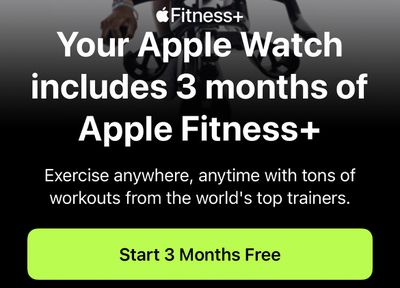Apple's fitness streaming service, Apple Fitness+, continues to be a strong competitor to Peloton, a well-established service that has become a significant player in the digital fitness space. Both Apple Fitness+ and Peloton offer a range of polished workout routines, delivered by enthusiastic instructors and accompanied by motivating music playlists.

As both subscription services share several similarities, such as offering a variety of workouts that require little to no equipment, it might not be immediately obvious which one is the better choice for individual needs. Our guide aims to answer this question by providing a comprehensive comparison of these two fitness subscription services, taking into account their latest features and pricing.
Peloton App Tiers
Apple Fitness+ is often compared to Peloton because both offer bike, treadmill, and rowing classes with a comparable digital experience. However, Peloton also sells a range of hardware products that integrate with its digital classes, enhancing the workout experience by connecting with the machine's resistance, cadence, and speed. This integration offers a more seamless experience for workouts on Peloton bikes or treadmills but comes at a higher cost, with equipment prices going up to $3,195, plus the need for a monthly subscription.

In contrast, Apple Fitness+ does not integrate with any equipment. With the recent restructuring of Peloton's digital offerings into tiered subscriptions – Peloton App Free, Peloton App One, and Peloton App+ – the comparison with Apple Fitness+ becomes more nuanced.
These tiers range from a basic, freemium model offering limited access (Peloton App Free) to a comprehensive, premium subscription (Peloton App+), giving users a broad spectrum of digital workout options without the need for Peloton's physical equipment. This tiered approach positions Peloton's digital offerings as a more direct competitor to Apple Fitness+, catering to a wider range of users with varying needs and preferences.
Comparing Apple Fitness+ and Peloton
Apple Fitness+ and Peloton share a number of attributes, such as four types of workout and an equipment-lite emphasis:
Similarities
- Strength, cycling, treadmill, yoga, pilates, and meditation workouts
- Highly-trained, charismatic instructors
- Curated music during workouts
- Equipment-lite workouts, with most requiring no equipment, or just a mat and dumbbells
- Workouts can be downloaded for offline use
- Integration with Apple Watch (to varying degrees)
- Diverse workout library catering to different fitness levels
- Ability to track and monitor workout progress
- Available on iPhone, iPad, and Apple TV
- Both services offer new content updates regularly
The differences between Apple Fitness+ and Peloton are more pronounced when it comes to additional workouts not offered by the rival service and pricing.
Differences
| Apple Fitness+ | Peloton |
|---|---|
| Additional HIIT, core, rowing, dance, pilates, kickboxing, and mindful cooldown workouts | Additional cardio, outdoor, running, walking, boxing, barre, and stretching workouts |
| Time to Walk and Time to Run audio episodes | |
| Full integration with Apple Watch and Activity Rings | Limited Apple Watch and Activity Ring integration |
| Pre-recorded workouts | Pre-recorded and interactive live workouts |
| Apple Music integration and Artist Spotlights | Apple Music and Spotify integration via the Peloton app |
| Apple devices only | Also available on Amazon Fire TV, Chromecast, Android TV, and Roku TV |
| $9.99/month or $79.99/year |
App Tiers: Free, App One ($12.99/month or $129/year), and App+ ($24/month or $240/year) |
| Included in Apple One Premier Tier subscription for $29.95 per month, family access available | Special pricing tiers on the Peloton App offered for various professions and communities in the U.S. |
Read on for a closer look at each of these aspects, and see what exactly both fitness subscription services have to offer.
Workout Types
Both services espouse a selection of workouts to appeal to a broad audience, but there are slight differences in what each offers. Apple Fitness+ features 12 workouts:
- High-Intensity Interval Training (HIIT)
- Strength
- Yoga
- Meditation
- Pilates
- Dance
- Core
- Cycling
- Kickboxing
- Treadmill (for running and walking)
- Rowing
- Mindful Cooldown
Peloton offers 16 workouts across its app tiers, including:
- Strength
- Yoga
- Meditation
- Cardio
- Stretching
- Cycling
- Outdoor
- Running
- Walking
- Tread Bootcamp
- Bike Bootcamp
- Boxing
- Pilates
- Barre
- Rowing
- Row Bootcamp
Both Apple Fitness+ and Peloton offer a variety of workouts to cater to different fitness preferences. They share common workout types like strength, cycling, treadmill, yoga, and meditation, yet there are some important distinctions.

Apple Fitness+ features specific workouts that Peloton lacks such as high-intensity interval training (HIIT), core, dance, and mindful cooldown. These workouts are clearly categorized, making it easier for users to understand what each session entails. Peloton, with its new tiered app structure, offers a wide range of workouts including cardio, outdoor running, stretching, tread bootcamp, and bike bootcamp, in addition to the common types. While Peloton provides a broad array of choices, it may be less clear in its categorization compared to Apple Fitness+, but members are able to search for what they are looking for.

Both services have their unique strengths: Apple Fitness+ with its clear categorization and unique workout types such as dance and HIIT, and Peloton with its more extensive range and integration with equipment. The choice between the two ultimately depends on individual preferences, workout goals, and desired workout experiences.
Workout Videos
Peloton offers live-streaming classes, creating a dynamic and interactive workout experience. Users can engage in real-time with instructors and other participants, including features like virtual high-fives for encouragement.
Both Apple Fitness+ and Peloton provide the option to download workouts for offline use. This feature is particularly beneficial for users with limited or unreliable internet access, or those who often travel. While Apple Fitness+ focuses on pre-recorded, on-demand content, Peloton combines this with the unique element of live workouts.

In essence, if real-time interaction and community engagement are important to you, Peloton offers a compelling experience with its live-streaming classes. For those who prioritize flexibility and the convenience of offline access, both Apple Fitness+ and Peloton cater to these needs.
App Access
Both Apple Fitness+ and Peloton offer multi-platform access, but with some differences. Apple Fitness+ is available on Apple TV, iPad, and iPhone, catering to users within the Apple ecosystem. In contrast, Peloton's app, now available in different tiers, extends its reach to a broader audience. It is accessible to Apple and Android devices, Amazon Fire TV, Apple Watch, Chromecast, Android TV, Apple TV and Roku TV.

For Android users or those not deeply integrated into Apple's ecosystem, Peloton offers more versatility with its wider platform support.
Integrations
Apple Fitness+ heavily integrates with Apple devices such as the Apple Watch. When a user initiates a Fitness+ workout on their iPhone, iPad, or Apple TV, their Apple Watch will automatically sync and track that type of workout. Users can also easily pause workouts from their Apple Watch or simply by taking out an AirPod.

One of the biggest highlights of Apple Fitness+ is the ability to see your Apple Watch metrics on-screen in real-time. Users can see their Activity Rings in the top right corner of the screen, while the opposite corner has the elapsed time of the workout, heart rate, and calories burned. Some workouts also feature the "Burn Bar," which is an indicator of how much effort you are putting in compared to other users. Instructors will often highlight and enlarge different metrics as you complete your workout.

Fitness+ is also integrated with Apple Music, but a subscription is not required to use the service. If you do have an Apple Music subscription, you will be able to easily save tracks you enjoy from workouts.
Peloton has enhanced its Apple Watch integration, allowing users to track Strive Score and close their Activity Rings during workouts. This is available with the Peloton App, Bike, Bike+, Tread, and Row. The integration allows for heart rate monitoring and helps users seamlessly log their workouts in the Activity app, contributing to closing their rings.
In addition to the Apple Watch integration, Peloton's own equipment, including the Bike, Bike+, Tread, and Row, provides comprehensive workout metrics and tracking. These devices offer real-time performance data like resistance, cadence, and speed, enhancing the workout experience. Peloton also incorporates basic music features, allowing users to interact with curated playlists during their workouts.
Family Use
Peloton, now with its tiered app system, continues to be rated "12+" on the App Store due to "Infrequent/Mild Mature/Suggestive Themes" and "Infrequent/Mild Profanity or Crude Humor." This rating accounts for occasional classes where instructors might use profanity or play explicit music. However, these instances are clearly labeled, allowing users to make informed choices about the content.
Apple Fitness+ maintains its family-friendly approach with music and instructors that generally avoid profanity, making it a suitable option for households with younger members. The service's emphasis on inclusivity and accessibility makes it a preferred choice for families seeking fitness solutions that cater to all ages.
New Content
Apple Fitness+ continues to expand its offerings, adding new workouts and content every week, including the recently introduced Artist Spotlight series. Peloton, with its established presence in the fitness industry, boasts a vast content library including Artist Series and Featured Collections. The introduction of new app tiers – Peloton App Free, Peloton App One, and Peloton App+ – has further diversified their workout catalog. Peloton frequently updates its library with new classes, including live-streamed sessions, providing a dynamic range of options for subscribers.

Both services, Apple Fitness+ and Peloton, offer extensive and regularly updated content, catering to a wide range of fitness interests and levels. While Peloton has a larger historical library, Apple Fitness+ is rapidly growing its collection, making both platforms competitive in their offerings.
In addition to its regular workout updates, Apple Fitness+ launched unique features like "Time to Walk" and "Time to Run." "Time to Walk" is an inspiring audio walking experience on the Apple Watch for Fitness+ subscribers. It features influential people sharing stories, photos, and music, aiming to encourage users to walk more often. Similarly, "Time to Run" is designed to help users become more consistent and better runners through a series of guided runs. These features are updated regularly with new episodes, adding more variety and depth to the Fitness+ content library, and enhancing the user experience beyond traditional workouts.
Pricing
Apple Fitness+ remains competitively priced at $9.99 per month or $79.99 annually, offering savings when opting for the annual subscription. It also allows up to six family members to share the subscription at no additional cost.
Peloton, following its recent restructuring, now offers several subscription tiers: Peloton App Free (free), Peloton App One ($12.99/month or $129/year), and Peloton App+ ($24/month or $240/year). The App One and App+ tiers provide more extensive access to classes and features. Peloton's pricing for family use and whether additional profiles are available under each tier have not been specified.
Apple Fitness+ is also part of the Apple One Premier bundle, priced at $29.95 per month, which includes other Apple services like Apple Music, Apple Arcade, Apple News+, and Apple TV+. This bundle can offer additional value for users already invested in Apple's ecosystem.
In comparison, Apple Fitness+ generally offers a more cost-effective solution, especially for families or those using multiple Apple services. Peloton's tiered structure provides flexibility but can be more costly, especially for the App+ tier.
Free Trials
Peloton offers a free app tier, Peloton App Free, with a selection of 50 rotating classes across various workout types. This tier allows users to experience Peloton's fitness classes without any cost, making it an accessible option for those new to the service or unsure about committing to a paid subscription. Advanced features like live classes, complete workout tracking, and full access to specialty content are reserved for Peloton's paid tiers.

Peloton provides a 30-day free trial for new users to explore either the App One or App+ membership. This trial includes full access to all classes and features of the chosen tier. Post-trial, users are automatically billed for the monthly membership of the selected tier.
Apple offers a generous free trial for Apple Fitness+. Customers who buy a new Apple Watch or another eligible Apple device can redeem up to three months of Apple Fitness+ for free.
Final Thoughts
If you are still weighing your options between Apple Fitness+ and Peloton, it's advisable to take advantage of their free trials. This allows you to try each service, helping you to determine which you prefer.
Apple Fitness+ remains a more budget-friendly option compared to Peloton, especially when considering family use or bundling with other Apple services. While Apple Fitness+ can be used without an Apple Watch, having one enhances the experience significantly. For the majority of users, particularly including beginners and those with a more casual approach to working out, Apple Fitness+'s comparatively low cost and clearer, simpler approach to workouts will be more accessible.
Peloton, with its tiered subscription model, caters to a wider audience, from casual users to serious gym-goers and athletes. Its expanded offerings include live classes and interactive features, making it a strong choice for those seeking a more engaging and professional workout experience with added motivation and social features.
Ultimately, your choice depends on personal preferences, workout styles, the devices you already have, and how you want to integrate these services into your lifestyle. Apple Fitness+ excels in seamless integration within the Apple ecosystem, while Peloton offers a broader platform compatibility and a variety of interactive workout experiences.



















Top Rated Comments
If you have Peloton hardware, go with the Peloton app.
If you have only the standard home fitness equipment (weights, resistance bands, yoga or workout mat), go with Apple Fitness+
"Apple Fitness+ features specific workouts that Peloton lacks such as high-intensity interval training (HIIT), core, dance, pilates, and mindful cooldown."
These are exercises in Peloton. Perhaps they aren't categorized as such, but there are HIIT exercises, and core exercises, and meditative cooldowns, etc. Just wouldn't want people to think that these things are just entirely absent.
I also find the variety of music and instructors on Peloton to be FAR broader than AF+. I prefer rock (mainly indie or alternative) to pop or dance, and AF+ definitely skews pop. While this is true of Peloton too, Peloton is cranking out more classes every day, and so they put out more classes to my musical liking than AF+ through sheer volume. My wife mixes in a lot more Yoga and strength classes and also prefers Peloton, though I think she prefers the movements and methods. I will say, AF+ has excellent production quality and the video resolution seems to be higher as well.
I don't have a Peloton bike (I use a Keiser M3) so it's not about hardware lock-in. I just find the experience on Apple inferior overall.
[unrelated rant] I've now bailed on Apple One because it went from $29.95 to $37.95 in a single year. I only really need the 2TB iCloud Plus but tried to love all of the other services (incl. Apple fitness) and just couldn't. [/unrelated rant]